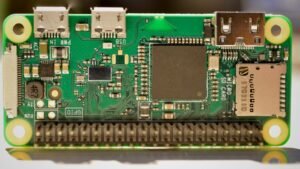What Is Computer Graphics Algorithms?
Computer graphics algorithms are at the core of creating and manipulating digital images, animations, and visual effects. These algorithms allow us to transform and render objects in a virtual three-dimensional space, making computer-generated imagery (CGI) possible in video games, movies, virtual reality, and other digital platforms.
Key Takeaways
- Computer graphics algorithms are essential for creating digital images and visual effects.
- They enable the transformation and rendering of objects in a virtual three-dimensional space.
- These algorithms play a crucial role in video games, movies, virtual reality, and other digital platforms.
Computer graphics algorithms involve various mathematical and computational techniques, striving to produce realistic images and animations. From the moment an object is created digitally, these algorithms take charge of its appearance, movement, and interaction with light sources. By simulating the physics of light, shading, and reflection, they create the illusion of depth and realism in the final output.
One interesting aspect of computer graphics algorithms is their ability to generate complex and detailed images using a sequence of simple geometric primitives. Through rasterization, geometric shapes such as triangles, lines, and points are transformed into a grid of pixels, forming the building blocks of the final image.
There are several key algorithms commonly used in computer graphics, each serving a specific purpose. These algorithms include:
- Line drawing algorithms: Responsible for rendering lines and curves on the screen, these algorithms determine the color and position of each pixel. Bresenham’s line algorithm is a widely used example.
- Polygon filling algorithms: Used to fill the interior of polygons with color or patterns, these algorithms divide the polygon into smaller regions and determine the color of each pixel within those regions. The scanline algorithm is a popular method for polygon filling.
- Transformation algorithms: Involved in transforming objects from one coordinate system to another, these algorithms handle translation, rotation, scaling, and other transformations. The transformation matrix algorithm is commonly utilized.
- Hidden surface removal algorithms: Used to determine which surfaces are visible in a scene, these algorithms eliminate hidden or occluded surfaces from the final image. The painter’s algorithm and z-buffering are well-known methods for hidden surface removal.
- Ray tracing algorithms: These algorithms simulate the path of light rays in the scene and calculate the interaction of light with objects, leading to advanced effects such as reflections, refractions, and shadows. Ray tracing is computationally intensive but produces visually stunning results.
In addition to these algorithms, computer graphics also rely on efficient data structures to store and manipulate the geometric information of objects. Examples of such data structures include the scene graph, which represents the objects and their relationships in the scene, and spatial partitioning structures like bounding volume hierarchies, used for efficient traversal and culling of objects during rendering.
Tables
Table 1: Comparison of Line Drawing Algorithms
| Algorithm | Advantages | Disadvantages |
|---|---|---|
| Bresenham’s line algorithm | Highly efficient, uses only integer arithmetic | Only handles lines of positive slope |
| DDA line algorithm | Handles lines of any slope | Requires floating-point arithmetic, less efficient than Bresenham’s algorithm |
Table 2: Comparison of Polygon Filling Algorithms
| Algorithm | Advantages | Disadvantages |
|---|---|---|
| Scanline algorithm | Handles concave and convex polygons efficiently | May produce artifacts on polygons with intersecting edges |
| Seed fill algorithm | Handles polygons with holes | May suffer from slow performance on complex polygons |
Table 3: Comparison of Hidden Surface Removal Algorithms
| Algorithm | Advantages | Disadvantages |
|---|---|---|
| Painter’s algorithm | Simple to implement | May produce rendering artifacts due to overlapping polygons |
| Z-buffering | Provides more accurate results | Requires additional memory to store depth information for each pixel |
Computer graphics algorithms continue to evolve and improve, pushing the boundaries of visual realism in digital media. By harnessing the power of mathematics and computation, these algorithms enable us to create breathtaking and immersive visual experiences that were once only possible in the real world.

Common Misconceptions
Misconception 1: Computer graphics algorithms only involve creating images and animations
One common misconception is that computer graphics algorithms simply revolve around generating visually appealing images and animations. While creating visuals is indeed an essential aspect of computer graphics, algorithms in this field encompass much more. Here are three relevant bullet points:
- Computer graphics algorithms also involve tasks like rendering, which determines how objects are displayed on a screen or other media.
- They include algorithms for manipulating and transforming graphical objects, such as scaling, rotating, and translating them.
- Computer graphics algorithms deal with computational geometry, which focuses on efficient algorithms for manipulating geometric shapes and calculating intersections.
Misconception 2: Computer graphics algorithms are only used in entertainment and gaming industries
Many people believe that computer graphics algorithms exclusively find application within the entertainment and gaming industries. However, the reach of these algorithms extends far beyond these areas. Here are three relevant bullet points:
- Computer graphics algorithms have extensive use in virtual reality and augmented reality applications, enabling realistic and immersive experiences.
- They are employed in scientific visualization to represent complex data in visual forms, making it easier to understand and analyze.
- Computer graphics algorithms are used in architectural and engineering fields to create digital prototypes and simulations of structures before their physical construction.
Misconception 3: Only highly specialized professionals can understand computer graphics algorithms
Some individuals perceive computer graphics algorithms as highly complex and assume that only a select few with deep technical knowledge can comprehend them. However, this is not entirely accurate. Here are three relevant bullet points:
- While advanced understanding may be required to develop novel computer graphics algorithms, many existing algorithms can be utilized by designers and developers with intermediate knowledge.
- Various programming frameworks and libraries provide simpler interfaces and pre-built algorithms, allowing non-experts to incorporate computer graphics functionalities into their projects.
- Introductory resources, tutorials, and online courses are available to help individuals grasp the fundamental concepts and principles behind computer graphics algorithms.
Misconception 4: Computer graphics algorithms only deal with 2D graphics
Some may wrongly assume that computer graphics algorithms are limited to dealing with two-dimensional graphics. However, computer graphics encompass both 2D and 3D representations. Here are three relevant bullet points:
- Computer graphics algorithms involve viewing transformations that project three-dimensional objects onto a two-dimensional screen or other media.
- They enable the rendering of 3D graphics with techniques like ray tracing, which simulates the way light interacts with objects in a realistic manner.
- Computer graphics algorithms include algorithms for scanning and rendering three-dimensional models using methods such as triangle rasterization.
Misconception 5: Computer graphics algorithms do not require mathematical knowledge
Another common misconception is that computer graphics algorithms can be implemented without a solid foundation in mathematics. However, mathematics plays a crucial role in the development and understanding of these algorithms. Here are three relevant bullet points:
- Linear algebra plays a key role in transformations, such as rotations, translations, and scaling of graphical objects.
- Geometric principles, such as vectors, matrices, and coordinate systems, are fundamental to many computer graphics algorithms.
- Understanding concepts like calculus and differential equations is necessary for advanced techniques, such as physics-based simulations or modeling natural phenomena.

Introduction
Computer graphics algorithms are fundamental techniques used in the creation, manipulation, and rendering of digital images. These algorithms play a crucial role in various fields, including multimedia, gaming, virtual reality, and computer-aided design. In this article, we explore ten intriguing aspects of computer graphics algorithms through informative tables.
The Number Pi in Graphics
The mathematical constant π (pi) finds its way into computer graphics algorithms in unexpected ways. Here are some fascinating relationships involving π:
| Aspect of Graphics | Relation to π |
|---|---|
| Bézier Curves | The basis functions for Bézier curves are defined using Bernstein polynomials, which rely on π. |
| Sine and Cosine Functions | These fundamental functions are linked to circular motion, where π represents half a full rotation. |
| Trigonometric Transformations | Rotation matrices, crucial for various transformations, utilize radians defined by π. |
| Circle Drawing | The midpoint circle algorithm relies on π to calculate positions along the circumference. |
Color Spaces and Models
Colors in computer graphics are represented and manipulated using different color spaces and models. Here are some intriguing color spaces:
| Color Space/Model | Description |
|---|---|
| RGB | A color model representing red, green, and blue values to create a wide range of colors. |
| CMYK | A color model used for printing, representing cyan, magenta, yellow, and key (black) inks. |
| XYZ | An abstract color space used to define all perceivable colors. |
| HSL/HSV | Color models representing hue, saturation, and lightness/value, allowing intuitive color selection. |
Hidden Surface Removal Techniques
Rendering complex scenes in computer graphics often requires removing hidden surfaces that should not be visible to the viewer. Here are some fascinating techniques:
| Technique | Description |
|---|---|
| Z-Buffering | Assigns a depth value to each pixel and determines which surface is closest to the viewer. |
| Binary Space Partitioning | Divides a scene into two regions based on a splitting plane to hierarchically determine visible surfaces. |
| Painter’s Algorithm | Renders surfaces from back to front based on their distance from the viewer. |
| Ray Tracing | Simulates the path of light rays to determine visibility, reflection, and refraction. |
Rasterization Techniques
Converting geometric shapes into raster images involves employing various techniques in computer graphics. Let’s explore some intriguing ones:
| Technique | Description |
|---|---|
| Bresenham’s Line Algorithm | A fast and accurate algorithm for rendering straight lines. |
| Scanline Rendering | Processes one scanline at a time, determining intersections with polygons to render them. |
| Texture Mapping | Applies a texture to a surface, creating realistic and detailed rendered images. |
| Anti-aliasing | Techniques used to reduce the visibility of jagged edges or aliasing artifacts in rasterized images. |
3D Transformations
Transforming three-dimensional objects is crucial for object manipulation and realistic rendering. Here are some captivating 3D transformations:
| Transformation | Description |
|---|---|
| Translation | Moves an object along a specified vector in 3D space. |
| Rotation | Rotates an object around an axis, simulating movement in three dimensions. |
| Scaling | Changes the size of an object uniformly or along specific dimensions in 3D space. |
| Shearing | Skews an object in one direction, altering its shape in 3D space. |
Shading Models
Shading techniques in computer graphics enable the realistic representation of lighting and material properties. Let’s explore some intriguing shading models:
| Model | Description |
|---|---|
| Phong Shading | Simulates the interaction between light sources, the viewer, and surfaces to generate smooth shading. |
| Gouraud Shading | Computes vertex colors and interpolates them across polygons, creating realistic shading effects. |
| Cel Shading | Produces a toon-like or comic style by reducing shading levels to a small, discrete set. |
| Flat Shading | Assigns a single color to each polygon, creating a flat, non-smooth appearance. |
Fractals in Computer Graphics
Fractals, self-repeating patterns or structures, are employed in computer graphics to create intricate and complex images. Here are some fascinating fractals:
| Fractal | Description |
|---|---|
| Mandelbrot Set | A famous fractal defined by a simple iterative algorithm, creating visually stunning patterns. |
| Julia Set | Similar to the Mandelbrot Set, Julia Set is another visually captivating fractal. |
| Sierpinski Triangle | A fractal pattern formed by recursively dividing a triangle into smaller triangles. |
| Barnsley Fern | A fractal image resembling a fern, generated using an iterated function system. |
Curve Interpolation in Animation
Creating smooth and natural animations often involves interpolating curves between keyframes. Here are some intriguing interpolation techniques:
| Technique | Description |
|---|---|
| Linear Interpolation (LERP) | Applies a linear progression between two values, creating a straight path. |
| Bézier Curve Interpolation | Utilizes the mathematical elegance of Bézier curves to create smooth and adjustable animations. |
| Spline Interpolation | Uses piecewise-defined curves to generate natural and flexible animations. |
| Hermite Interpolation | Employs Hermite polynomials to interpolate through keyframes, providing precise control over animation. |
Conclusion
Computer graphics algorithms play a remarkable role in generating visually stunning images, simulating realistic environments, and crafting captivating animations. From the mathematical influence of π to the creation of complex fractals, understanding and harnessing these algorithms unlocks endless possibilities in the world of digital graphics. By delving into diverse aspects of computer graphics, we gain insight into the fascinating and ever-evolving field that impacts our visual experiences every day.
Frequently Asked Questions
What is computer graphics algorithms?
Computer graphics algorithms refer to a set of mathematical and computational techniques used to generate, manipulate, and render images in digital form. These algorithms are used to create realistic or abstract visual representations on displays, including computer monitors, projectors, and other visual output devices.
How do computer graphics algorithms work?
Computer graphics algorithms work by transforming mathematical equations and geometric data into digital representations of visual elements, such as points, lines, shapes, and colors. These algorithms utilize various processes such as modeling, rendering, shading, and texturing to create lifelike or imaginary images.
What are some common computer graphics algorithms?
Some commonly used computer graphics algorithms include the Bresenham’s line algorithm for drawing lines, the DDA algorithm for line rasterization, the midpoint circle algorithm for drawing circles, the scanline algorithm for polygon fill, and the Phong shading algorithm for smooth shading.
Why are computer graphics algorithms important?
Computer graphics algorithms play a crucial role in various fields such as animation, video games, virtual reality, computer-aided design (CAD), and simulation. These algorithms enable the creation of visually appealing and interactive digital content that enhances user experiences and facilitates communication of complex ideas.
What are the challenges in developing computer graphics algorithms?
Developing computer graphics algorithms involves addressing several challenges, including achieving real-time performance, handling complex scenes with numerous polygons, simulating realistic lighting and shading effects, reducing artifacts such as aliasing, and ensuring compatibility across different hardware and software platforms.
Are there any specialized computer graphics algorithms for 3D modeling?
Yes, there are specialized computer graphics algorithms for 3D modeling. These algorithms are used to represent and manipulate three-dimensional objects in computer graphics applications. Examples of such algorithms include the marching cubes algorithm for surface reconstruction, the Catmull-Clark subdivision algorithm for smooth surface modeling, and the ray-triangle intersection algorithm for ray tracing.
How are computer graphics algorithms utilized in virtual reality?
In virtual reality (VR) applications, computer graphics algorithms are utilized to render immersive and interactive virtual environments. These algorithms are responsible for generating realistic textures, simulating lighting and shadows, rendering 3D objects, and providing smooth and responsive visual feedback to the user’s movements and interactions.
Are there any open-source libraries or frameworks available for computer graphics algorithms?
Yes, there are several open-source libraries and frameworks available for implementing computer graphics algorithms. Some popular ones include OpenGL, DirectX, WebGL, and Three.js. These libraries provide developers with a range of graphics functions and utilities to simplify the implementation and optimization of computer graphics algorithms.
What are some applications of computer graphics algorithms in everyday life?
Computer graphics algorithms find applications in various aspects of everyday life, including video games, movies and animation, architectural design and visualization, advertising and marketing, medical imaging, data visualization, and virtual reality experiences. Additionally, these algorithms play a crucial role in creating user interfaces, icons, and visual elements in mobile and desktop applications.
What academic background is useful for understanding computer graphics algorithms?
A strong foundation in mathematics, particularly linear algebra, calculus, and geometry, is beneficial for understanding computer graphics algorithms. Additionally, knowledge of programming languages, such as C++ and Python, is essential for implementing and optimizing these algorithms. Pursuing a degree in computer science, computer graphics, or a related field can provide the necessary knowledge to work with computer graphics algorithms.




